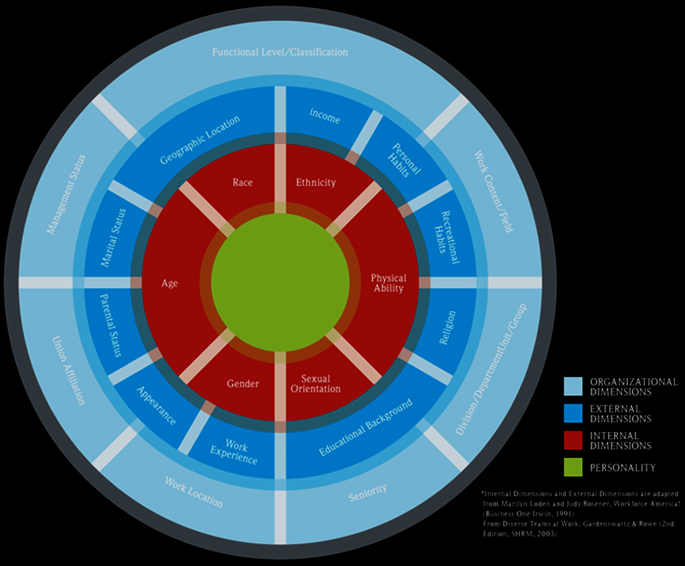Diversity Analysis
Business, Law and Ethical practices are the main motivation behinds any organization’s desire to develop an efficient diversity program. Failure to have a good diversity program in the organization is likely to lead to expensive consequences such as discrimination suits. Organizational culture analysis happens so that the organization is able to initiate and implement diversity training programs and organization values related to diversity awareness (Kinicki & Kreitner, 2009).
The Four Layer Model of Diversity
In managing diversity, organizational managers need to be aware of the different levels within the organization that diversity occurs. Individuals collectively make up the organization. Therefore, the individual’s personality forms the core of the diversity model.
In the personality layer, analysis concerns the likes and dislikes of the individual, their values and beliefs as shaped by their upbringing and the societies in which they grew up and live in. Different cultural backgrounds lead to the formation of different characteristics of individuals and hence their diversity. As the core of the diversity layer, personality influences other layers in the model.
The second inner most layer, internal dimension, consists of aspects that the individual has no direct control of, however subsequent actions can lead to an effective change in one of the aspects in the internal dimension. Internal dimension has ethnicity, physical ability, sexual orientation, gender, age and race, which form key divisions among people.
The aspects classified in the internal dimension are attributes that form the first perception of a person as viewed by others before notice is taken of their other attributes. After the internal dimension is the external dimension where an individual has a given control over the aspects attributed to this layer.
This layer forms the base for key career decisions and work preferences and as such it greatly influences the choice of friendship and work. Aspects of this layer are predictive of the outcomes of the individual preferences in hiring, promotions and engagement in other business practices.
The outermost layer of the diversity model is the organizational dimension, which presents an organizational view as shaped by the external dimension of the model. As individuals interact they form the culture of the organization. In this layer, opportunities for development and promotion within the organization occur in this layer.
An individual personality is formed by the internal dimensions while the organization’s personality is shaped by the external dimension and the organizational dimension. The figure below represents the four layer model (Amelio, n.d.).

Procedures of Analyzing Diversity
The task of analyzing organizational diversity may seem easy because it involves using sample participants to assess the compatibility of the organization with diversity standards. However, determining the extent to which the diversity of the company reaches beyond skin-deep is more important.
To analyze this extent, an organization accesses the participation of ‘down-line’ employees in their respective team communication. When the assessment indicates that the down-line employees are not providing an input on how their colleagues and other are affecting their job, and how their jobs can be made more efficient then the level of organizational involvement is low.
The analysis for diversity then needs the organization to have a thorough knowledge of its employee and their vast experience that they bring to the job. Thus the leadership should be flexible in its approach of new ideas. Thirdly, analysis involves scheduled periods for the organization to have an out of the box thinking session.
Without such session, leadership cannot effectively approach old problems using new ways that incorporate diversity awareness. The organizations most important employee assets are the diverse thinkers and therefore they should be identified through such scheduled out of the box thinking sessions (Doublestein, 2006).
The next step for the organization is to assess periodically each component of the organization and project fictitious outcomes of different organizational cultures and values. These sessions will provide each member of the organization with a chance to add something to the overall understanding of the diversity in the organization.
An thorough undertaking of the above steps will inform the organizational leadership whether there is a need to go further than the skin-deep analysis of diversity (Doublestein, 2006).
Implementation in a Cultural Diversity Training Program
An understanding of the four layer model is crucial in the development and implementation of diversity training for employees in the workplace. The diversity training has to incorporate all layers with a special emphasis on making individuals understand the diversity perspective from an organizational view and from a personal view.
As individuals the diversity training program will rely on the personal analysis of the internal dimension and how it has shaped their choices leading to their current position. The inner reflection will assist individuals to increase their self-esteem and express more of their individuality thus contributing to a rich organizational cultural diversity.
After an individual examination, diversity training programs reflect of how the individual relates or fails to relate to others within the organization based on the different aspects and layers identified. Ones noted the training program should formulate mechanisms to increase the tolerance among different people in the organization and inform senior management of the practices and values that should be put in place to ensure that all aspects of diversity are respected and harmonized within the organizational culture (Kinicki & Kreitner, 2009).
References
Amelio, R. (n.d.). The “Four Layers” model is essential to truly understanding your workforce. Web.
Doublestein, B. (2006). Diversity That is More Than Skin Deep. Web.
Kinicki, A., & Kreitner, R. (2009). Organizational Behavior: key concepts, skills & best practices. New York, NY: McGraw Hill Companies Inc.